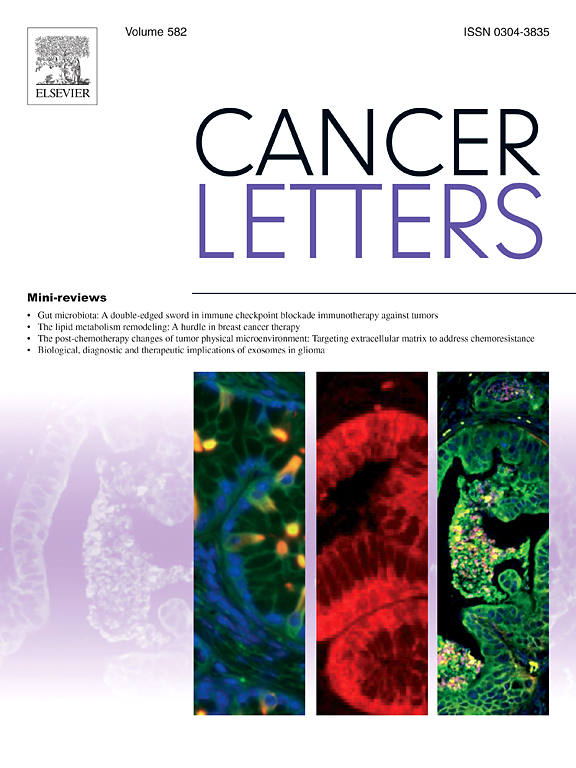COL1A1-positive endothelial cells promote gastric cancer progression via the ANGPTL4-SDC4 axis driven by endothelial-to-mesenchymal transition
IF 9.1
1区 医学
Q1 ONCOLOGY
引用次数: 0
Abstract
Gastric cancer (GC) is an aggressive and heterogeneous disease with poor survival outcomes. The progression of GC involves complex, multi-step processes. Endothelial cells (ECs) play a crucial role in tumor angiogenesis, proliferation, invasion, and metastasis, particularly through the process of endothelial-to-mesenchymal transition (EndoMT). However, the specific role and mechanisms of EndoMT in gastric cancer remain unclear. Based on 6 GC single-cell RNA-sequencing (scRNA-seq) cohorts (samples = 97), we established an EndoMT-related gene signature, termed EdMTS. Leveraging this gene signature, ssGSEA was applied to calculate sample scores across multiple bulk RNA-seq datasets, which include information on immunotherapy, metastasis, GC progression, and survival. Moreover, we applied the Monocle2 method to calculate cell pseudotime and used CellChat to analyze interactions between malignant and EC cells. We verified the molecular mechanism by multiple immunofluorescence and cell function experiments. Findings In this study, we established a single-cell atlas of ECs in GC and identified a subpopulation of COL1A1+ ECs that play a critical role in tumor progression and metastasis. These COL1A1+ ECs were significantly associated with worse clinical outcomes in GC patients. Further analysis revealed that COL1A1+ ECs originated from lymphatic ECs and underwent EndoMT through the upregulation of CEBPB, driving tumor invasiveness. Moreover, COL1A1+ ECs interacted with malignant cells via ANGPTL4-SDC4 axis, enhancing invasion and migration. These findings provide a deeper understanding of the role of COL1A1+ ECs in GC progression and highlight potential therapeutic targets for disrupting the EndoMT process in these cells to provide a benefit for GC patients.
COL1A1阳性内皮细胞通过内皮细胞向间质转化驱动的ANGPTL4-SDC4轴促进胃癌进展
胃癌(GC)是一种侵袭性和异质性疾病,生存预后差。GC的进展涉及复杂的、多步骤的过程。内皮细胞(ECs)在肿瘤血管生成、增殖、侵袭和转移中起着至关重要的作用,特别是通过内皮细胞向间充质细胞转化(EndoMT)的过程。然而,EndoMT在胃癌中的具体作用和机制尚不清楚。基于6个GC单细胞rna测序(scRNA-seq)队列(样本= 97),我们建立了endomt相关的基因标记,称为EdMTS。利用这种基因标记,ssGSEA应用于计算多个批量RNA-seq数据集的样本分数,其中包括免疫治疗、转移、胃癌进展和生存的信息。此外,我们应用Monocle2方法计算细胞假时间,并使用CellChat分析恶性细胞和EC细胞之间的相互作用。我们通过多次免疫荧光和细胞功能实验验证了其分子机制。在这项研究中,我们建立了胃癌中ECs的单细胞图谱,并确定了在肿瘤进展和转移中起关键作用的COL1A1+ ECs亚群。这些COL1A1+ ECs与GC患者较差的临床结果显著相关。进一步分析发现COL1A1+ ECs起源于淋巴ECs,并通过上调CEBPB进行EndoMT,驱动肿瘤侵袭性。此外,COL1A1+ ECs通过ANGPTL4-SDC4轴与恶性细胞相互作用,增强侵袭和迁移。这些发现为COL1A1+ ECs在胃癌进展中的作用提供了更深入的理解,并突出了破坏这些细胞中的EndoMT过程的潜在治疗靶点,为胃癌患者提供了益处。
本文章由计算机程序翻译,如有差异,请以英文原文为准。
求助全文
约1分钟内获得全文
求助全文
来源期刊

Cancer letters
医学-肿瘤学
CiteScore
17.70
自引率
2.10%
发文量
427
审稿时长
15 days
期刊介绍:
Cancer Letters is a reputable international journal that serves as a platform for significant and original contributions in cancer research. The journal welcomes both full-length articles and Mini Reviews in the wide-ranging field of basic and translational oncology. Furthermore, it frequently presents Special Issues that shed light on current and topical areas in cancer research.
Cancer Letters is highly interested in various fundamental aspects that can cater to a diverse readership. These areas include the molecular genetics and cell biology of cancer, radiation biology, molecular pathology, hormones and cancer, viral oncology, metastasis, and chemoprevention. The journal actively focuses on experimental therapeutics, particularly the advancement of targeted therapies for personalized cancer medicine, such as metronomic chemotherapy.
By publishing groundbreaking research and promoting advancements in cancer treatments, Cancer Letters aims to actively contribute to the fight against cancer and the improvement of patient outcomes.
 求助内容:
求助内容: 应助结果提醒方式:
应助结果提醒方式:


